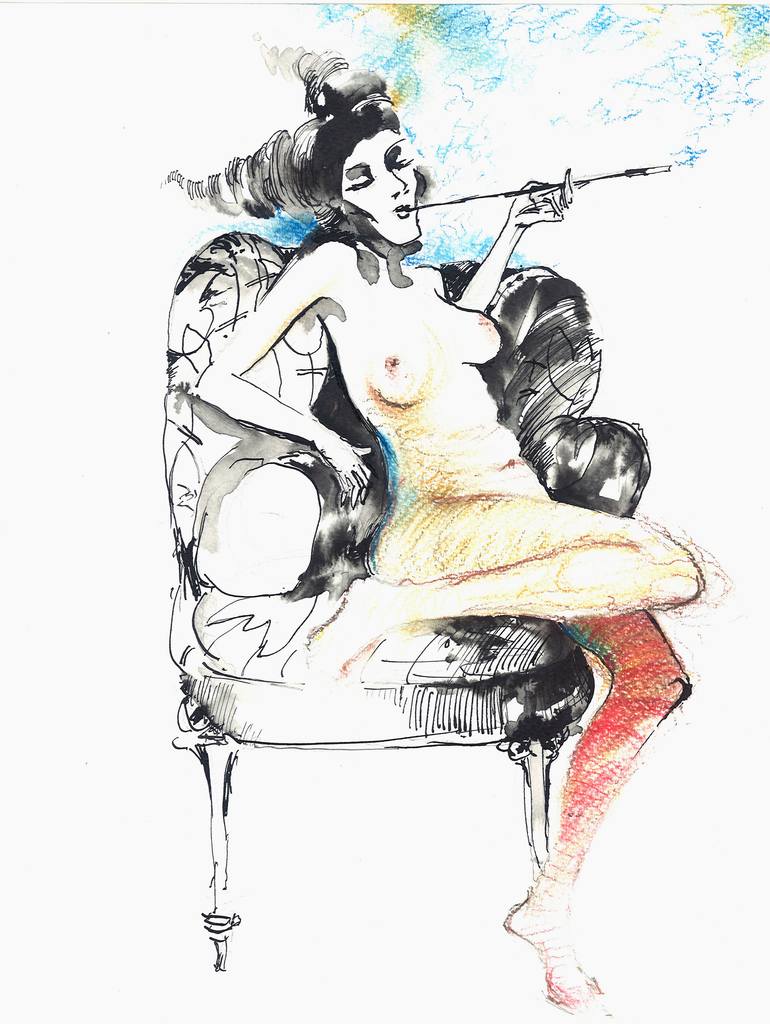





VIEW IN MY ROOM
Daisy Buchanan Print
Portugal
Select a Material
Canvas
Select a Size
12 x 16 in ($95)
Select a Canvas Wrap
Black Canvas
Add a Frame
White ($135)
Artist Recognition

Artist featured in a collection
About The Artwork
Debutante Daisy Buchanan The Great Gatsby is a 1925 novel written by American author F. Scott Fitzgerald that follows a cast of characters living in the fictional town of West Egg on prosperous Long Island in the summer of 1922. The story primarily concerns the young and mysterious millionaire Jay Gatsby and his quixotic passion and obsession for the beautiful former debutante Daisy Buchanan. Considered to be Fitzgerald's magnum opus, The Great Gatsby explores themes of decadence, idealism, resistance to change, social upheaval, and excess, creating a portrait of the Jazz Age or the Roaring Twenties that has been described as a cautionary tale regarding the American Dream. Set on the prosperous Long Island of 1922, The Great Gatsby provides a critical social history of America during the Roaring Twenties within its fictional narrative. That era, known for unprecedented economic prosperity, the evolution of jazz music, flapper culture, new technologies in communication (motion pictures, broadcast radio, recorded music) forging a genuine mass culture; and bootlegging, along with other criminal activity, is plausibly depicted in Fitzgerald's novel. Fitzgerald uses these societal developments of the 1920s to build Gatsby's stories from simple details like automobiles to broader themes like Fitzgerald's discreet allusions to the organized crime culture which was the source of Gatsby's fortune. Fitzgerald educates his readers about the garish society of the Roaring Twenties by placing a timeless, relatable plotline within the historical context of the era. Fitzgerald's visits to Long Island's north shore and his experience attending parties at mansions inspired The Great Gatsby's setting. Today, there are a number of theories as to which mansion was the inspiration for the book. One possibility is Land's End, a notable Gold Coast Mansion where Fitzgerald may have attended a party. Many of the events in Fitzgerald's early life are reflected throughout The Great Gatsby. Fitzgerald was a young man from Minnesota, and like Nick, he was educated at an Ivy League school, Princeton (in Nick's case, Yale). Fitzgerald is also similar to Jay Gatsby, in that he fell in love while stationed far from home in the military and fell into a life of decadence trying to prove himself to the girl he loved. Fitzgerald became a second lieutenant, and was stationed at Camp Sheridan, in Montgomery, Alabama. There he met and fell in love with a wild seventeen-year-old beauty named Zelda Sayre. Zelda finally agreed to marry him, but her preference for wealth, fun, and leisure led her to delay their wedding until he could prove a success.[8] Like Nick in The Great Gatsby, Fitzgerald found this new lifestyle seductive and exciting, and, like Gatsby, he had always idolized the very rich. In many ways, The Great Gatsby represents Fitzgerald's attempt to confront his conflicting feelings about the Jazz Age. Like Gatsby, Fitzgerald was driven by his love for a woman who symbolized everything he wanted, even as she led him toward everything he despised. In her book Careless People: Murder, Mayhem and the Invention of 'The Great Gatsby (2013), Sarah Churchwell speculates that parts of the ending of The Great Gatsby were based on the Hall-Mills Case. Based on her forensic search for clues, she asserts that the two victims in the Hall-Mills murder case inspired the characters who were murdered in The Great Gatsby.
Details & Dimensions
Print:Giclee on Canvas
Size:12 W x 16 H x 1.25 D in
Size with Frame:13.75 W x 17.75 H x 1.25 D in
Frame:White
Canvas Wrap:Black Canvas
Ready to Hang:Yes
Packaging:Ships in a Box
Shipping & Returns
Delivery Time:Typically 5-7 business days for domestic shipments, 10-14 business days for international shipments.
Handling:Ships in a box. Art prints are packaged and shipped by our printing partner.
Ships From:Printing facility in California.
Have additional questions?
Please visit our help section or contact us.
Portugal
Since 1983 Georgi Charaka has devoted most of his time to his personal work. He lives and works in Lisbon since 1999. He is a member of the Portuguese Association of Artists. Charaka was born in Bulgaria, where he graduated in the field of ceramics and glass in Sofia. In 1981-83 he worked as a product designer for sportswear factory “Orpheus”, after which in 1983 he started his own company, called “Tea”. For 15 years he was working as a ceramic, which he calls his primary passion of arts. In 1999 he moved to Lisbon, where he first started as interior walls decorator and restorer. Since 2002 he works as freelance artist in the field of aquarelle and acrylic painting.
Artist Recognition

Artist featured by Saatchi Art in a collection
Thousands Of Five-Star Reviews
We deliver world-class customer service to all of our art buyers.
Global Selection
Explore an unparalleled artwork selection by artists from around the world.
Satisfaction Guaranteed
Our 14-day satisfaction guarantee allows you to buy with confidence.
Support An Artist With Every Purchase
We pay our artists more on every sale than other galleries.
Need More Help?